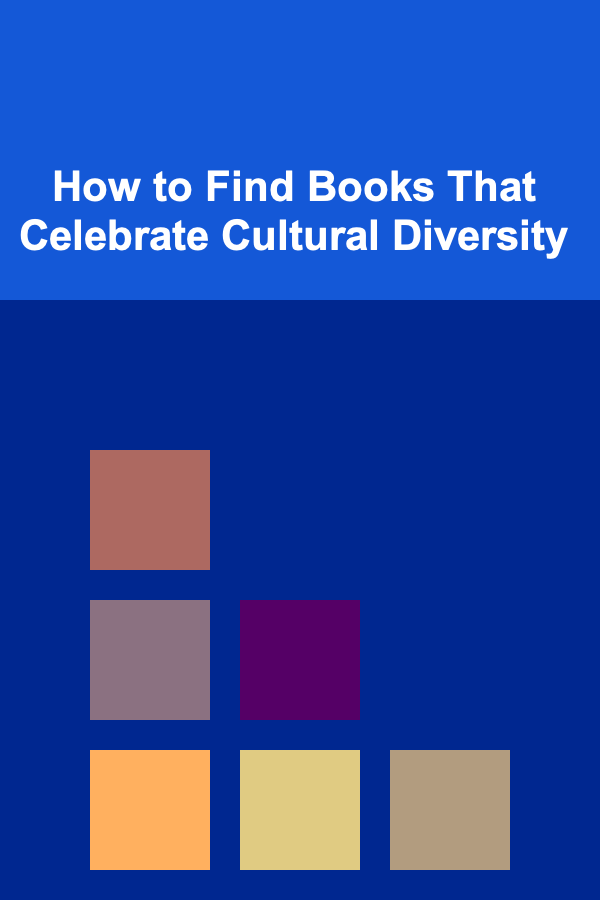
How to Find Books That Celebrate Cultural Diversity
ebook include PDF & Audio bundle (Micro Guide)
$12.99$8.99
Limited Time Offer! Order within the next:

Introduction: The Importance of Diverse Literature
In an increasingly interconnected world, the importance of understanding and appreciating different cultures cannot be overstated. Literature plays a crucial role in fostering empathy, broadening perspectives, and dismantling stereotypes. Books that celebrate cultural diversity offer readers windows into different ways of life, traditions, and beliefs, promoting tolerance, respect, and a deeper understanding of the human experience. They are vital tools for creating a more inclusive and equitable society.
This article will delve into various strategies for finding books that authentically represent and celebrate cultural diversity. It will explore resources, evaluation criteria, and best practices to help readers, educators, and librarians curate collections that reflect the richness and complexity of our world. Finding such books is not merely about ticking a box for inclusivity; it is about actively seeking narratives that challenge dominant perspectives, amplify marginalized voices, and promote cross-cultural understanding.
We will explore the nuances of representation, discuss how to identify potentially problematic tropes, and offer practical tips for building a diverse reading list. The goal is to equip you with the knowledge and resources necessary to choose books that are not only engaging but also contribute positively to a more informed and compassionate worldview.
Understanding What Makes a Book "Culturally Diverse"
Before embarking on the search for diverse books, it's essential to define what we mean by "cultural diversity." This encompasses more than just depicting characters from different racial or ethnic backgrounds. It includes exploring various aspects of human culture, such as:
- Race and Ethnicity: Stories featuring characters from various racial and ethnic groups, going beyond superficial representations to explore the complexities of their experiences.
- Religion: Depictions of different religious beliefs and practices, avoiding stereotypes and promoting understanding.
- Socioeconomic Status: Narratives that explore the lives and challenges of individuals from different socioeconomic backgrounds.
- Gender Identity and Sexual Orientation: Stories that celebrate the diversity of gender identities and sexual orientations, promoting acceptance and understanding.
- Disability: Representations of individuals with disabilities that are authentic and respectful, avoiding ableist tropes.
- Geographic Region and Nationality: Stories that explore different cultures and traditions from around the world.
- Age and Generational Differences: Narratives highlighting the unique perspectives and experiences of different age groups.
Furthermore, a truly culturally diverse book goes beyond simple representation to offer authentic and nuanced portrayals of these identities. It avoids stereotypes, challenges dominant narratives, and allows characters to be fully realized individuals with their own agency and perspectives.
It's important to remember that diversity is not a monolith. Within each of these categories, there is immense variation and complexity. For example, "Asian" is not a single culture, but encompasses a vast range of ethnicities, languages, and traditions. A good culturally diverse book will acknowledge and celebrate this internal diversity.
Where to Find Diverse Books: Resources and Strategies
There are numerous resources available to help you find books that celebrate cultural diversity. Here are some effective strategies:
1. Online Databases and Review Sites:
- We Need Diverse Books (WNDB): This non-profit organization is dedicated to increasing diversity in children's literature. Their website features book lists, author interviews, and resources for educators.
- ColorLines: Offers book reviews and recommendations focused on racial justice and cultural diversity.
- The Horn Book Magazine: Provides reviews of children's and young adult books, often highlighting diverse titles.
- School Library Journal: Features reviews and articles relevant to school librarians, including recommendations for diverse books.
- Kirkus Reviews: A well-respected book review publication that often includes diverse titles in its reviews.
- Goodreads: Utilize Goodreads' lists and recommendations by searching for terms like "diverse books," "multicultural books," or specific cultural groups.
- Book Riot: A website dedicated to all things books, including regular features on diverse literature.
- Reading Rainbow Skybrary: (If accessible) Offers a curated collection of diverse children's books.
- Database of Indigenous Literature: A resource focused on literature by and about Indigenous peoples.
2. Book Awards and Recognition Programs:
- The Coretta Scott King Book Awards: Awarded annually to African American authors and illustrators for outstanding books for children and young adults.
- The Pura Belpré Award: Presented to a Latino/Latina writer and illustrator whose work best portrays, affirms, and celebrates the Latino cultural experience.
- The American Indian Youth Literature Awards: Recognizes and honors the very best writing and illustrations by Native American authors and illustrators.
- The Stonewall Book Awards: Given to English-language books of exceptional merit relating to the gay, lesbian, bisexual, and transgender experience.
- The Asian/Pacific American Award for Literature: Honors outstanding works about Asian/Pacific Americans and their heritage.
- The Walter Dean Myers Awards for Outstanding Children's Literature: Recognizes diverse authors and illustrators whose works feature diverse main characters and address diversity in a meaningful way.
3. Independent Bookstores and Libraries:
- Support Independent Bookstores: Many independent bookstores specialize in diverse literature or have sections dedicated to it. Their staff can often provide personalized recommendations.
- Consult Librarians: Librarians are trained to curate collections and can offer valuable assistance in finding diverse books. They often have access to resources and databases that are not publicly available. Ask for recommendations, curated lists, or information about local book clubs focused on diverse reads.
4. Author Websites and Interviews:
- Explore Author Websites: Many authors who write diverse books have websites with information about their work, including interviews and articles that provide insight into their perspectives and writing process.
- Read Interviews: Look for interviews with authors in literary magazines, podcasts, and online publications. This can help you understand their motivations for writing diverse stories and their approaches to representation.
5. Educational Resources and Organizations:
- Teaching Tolerance: Provides resources and tools for educators to promote tolerance and understanding in the classroom, including book recommendations.
- The Conscious Kid: Offers resources for parents and educators on raising children with a focus on equity and inclusion, including book reviews and recommendations.
- Social Justice Books: Provides lists of books on various social justice topics, including race, gender, and disability.
6. Community Groups and Organizations:
- Connect with Cultural Organizations: Organizations dedicated to specific cultures or communities often have reading lists or recommendations for books that accurately and respectfully represent their experiences.
- Join Book Clubs: Participate in book clubs that focus on diverse literature. This provides an opportunity to discuss books with others and learn from their perspectives.
7. Social Media:
- #OwnVoices Hashtag: This hashtag is used to identify books written by authors from marginalized communities about their own experiences. It's a helpful way to find authentic and representative stories.
- Follow Diverse Book Reviewers and Bloggers: Many reviewers and bloggers specialize in diverse literature and offer insightful recommendations.
Evaluating Books for Cultural Authenticity and Accuracy
Finding books is just the first step. It's crucial to evaluate them for cultural authenticity and accuracy. Here are some key questions to consider:
1. Author's Background and Perspective:
- Who is the author? Research the author's background and experience. Are they from the culture they are writing about? If not, have they done their research and consulted with members of the community?
- #OwnVoices: Is the book an #OwnVoices book, meaning it's written by an author from the same community as the characters they are portraying? #OwnVoices stories often offer more authentic and nuanced perspectives.
- Sensitivity Readers: Has the author used sensitivity readers from the cultural group being represented? Sensitivity readers can identify potential biases, stereotypes, and inaccuracies in the manuscript.
2. Representation of Characters and Culture:
- Are the characters fully realized individuals? Do they have their own agency, motivations, and complexities? Avoid books where characters are reduced to stereotypes or used as props to advance the plot.
- Is the culture portrayed accurately and respectfully? Does the book avoid harmful stereotypes and generalizations? Does it celebrate the richness and diversity of the culture?
- Is the language used authentic and respectful? Avoid books that use slang or dialects in a condescending or mocking way.
- Are cultural details accurate? Pay attention to details such as food, clothing, customs, and traditions. Are they portrayed accurately and with respect?
- Are there multiple perspectives within the culture represented? One book cannot represent the entirety of a culture. Look for books that acknowledge the diversity within a community and avoid presenting a single, monolithic view.
- Is the story told from an insider's perspective when appropriate? Certain stories are best told from within a cultural context, allowing for nuance and understanding that an outsider might miss.
3. Avoidance of Harmful Tropes and Stereotypes:
- The "Magical Negro" Trope: Avoid books where a Black character exists solely to help the white protagonist.
- The "Noble Savage" Trope: Be wary of depictions of Indigenous peoples as inherently spiritual or connected to nature in a way that romanticizes and simplifies their cultures.
- The "Dragon Lady" or "Geeky Asian" Stereotypes: Avoid books that perpetuate harmful stereotypes about Asian women or men.
- Tokenism: Does the book include diverse characters simply to check a box, without giving them meaningful roles or development?
- Cultural Appropriation: Does the author borrow elements from another culture without understanding or respecting their significance?
- White Savior Narratives: Avoid stories where a white character saves or rescues characters from other cultures.
- Single Story Narratives: Be mindful of stories that present a single, limited view of a culture, ignoring its complexities and diversity. Encourage multiple perspectives.
4. Language and Tone:
- Is the language respectful and inclusive? Avoid books that use offensive or derogatory language.
- Is the tone respectful and empathetic? Does the author approach the subject matter with sensitivity and understanding?
- Are there any microaggressions present? Microaggressions are subtle, often unintentional, expressions of prejudice. Be aware of these subtle biases in the writing.
5. Context and Historical Accuracy:
- Is the historical context accurate? If the book deals with historical events, ensure that they are portrayed accurately and with appropriate sensitivity.
- Does the book provide sufficient context for readers to understand the cultural background? Avoid assuming that readers will already be familiar with the culture being depicted.
6. Seek Out Diverse Reviews and Opinions:
- Read reviews from diverse sources. Don't rely solely on mainstream reviews. Seek out reviews from reviewers and bloggers who are members of the culture being represented.
- Discuss the book with others from the culture. If possible, discuss the book with people from the culture it depicts to get their perspectives on its accuracy and authenticity.
By carefully considering these factors, you can choose books that not only entertain but also promote cultural understanding and respect.
Beyond Representation: The Power of Storytelling and Empathy
While representation is crucial, it's also important to remember the power of storytelling itself. A well-crafted story, regardless of the characters' backgrounds, can foster empathy and connect readers to universal human experiences. Books that explore themes of love, loss, friendship, resilience, and identity can resonate with readers from all backgrounds.
Consider these aspects of storytelling that contribute to building empathy and understanding:
- Character Development: Engaging and well-developed characters allow readers to connect with their emotions, motivations, and struggles.
- Compelling Narratives: Stories that are well-paced, engaging, and thought-provoking can capture readers' attention and inspire them to think differently about the world.
- Exploration of Universal Themes: Stories that explore universal themes such as love, loss, friendship, and identity can resonate with readers from all backgrounds.
- Authentic Voice: A strong and authentic voice can bring a story to life and make it more relatable to readers.
Furthermore, encourage readers to reflect on their own biases and assumptions. Reading diverse books can be a powerful tool for self-reflection and personal growth. Ask yourself questions such as:
- How did this book challenge my assumptions about this culture?
- What did I learn about this culture that I didn't know before?
- How did this book make me feel?
- How can I use what I learned from this book to be a more inclusive and understanding person?
Building a Diverse Bookshelf: Practical Tips
Creating a diverse bookshelf isn't just about finding individual books; it's about curating a collection that reflects the richness and complexity of our world. Here are some practical tips:
- Start Small and Be Intentional: Don't feel pressured to completely overhaul your bookshelf overnight. Start by adding a few diverse titles each month and gradually expand your collection.
- Prioritize #OwnVoices Books: Give preference to books written by authors from marginalized communities about their own experiences.
- Read Widely: Explore books from different genres, age groups, and regions of the world.
- Support Diverse Authors and Illustrators: Purchase books from diverse authors and illustrators to support their work and encourage them to continue creating diverse stories.
- Donate Books: Donate diverse books to schools, libraries, and community organizations to make them more accessible to others.
- Engage in Conversations: Talk about diverse books with your friends, family, and community members. Share your recommendations and learn from others.
- Continuously Educate Yourself: Stay informed about issues of diversity and inclusion. Read articles, attend workshops, and engage in conversations with others to deepen your understanding.
- Be Open to Feedback: Be open to feedback about the books you choose. If someone points out a problematic element in a book, be willing to listen and learn.
- Diversify Your Media Consumption: Extend your commitment to diversity beyond books. Seek out diverse movies, TV shows, music, and art.
- Remember it's a Journey: Building a diverse bookshelf is an ongoing process. Be patient with yourself and continue to learn and grow.
Conclusion: Embracing Diversity Through Literature
Finding books that celebrate cultural diversity is an ongoing journey, requiring diligence, critical thinking, and a willingness to learn. By utilizing the resources and strategies outlined in this article, readers, educators, and librarians can curate collections that authentically represent and celebrate the richness and complexity of our world.
Remember that the goal is not simply to find books that meet a certain criteria, but to engage with stories that challenge our assumptions, broaden our perspectives, and foster empathy and understanding. By embracing diversity through literature, we can create a more inclusive and equitable society for all.
The power of stories to shape our understanding of the world is immense. Let us harness that power to build bridges, break down barriers, and celebrate the beauty of human diversity.

How to Build a DIY Soundproofing Solution for Your Home
Read More
How to Use Multifunctional Furniture for Storage in Small Apartments
Read More
How To Understand Cultural Approaches to Health and Wellness
Read More
Understanding the Biology of Sharks: A Deep Dive
Read More
How To Overcome Writer's Block Permanently
Read More
How to Track Charitable Donations for Maximum Tax Benefits
Read MoreOther Products

How to Build a DIY Soundproofing Solution for Your Home
Read More
How to Use Multifunctional Furniture for Storage in Small Apartments
Read More
How To Understand Cultural Approaches to Health and Wellness
Read More
Understanding the Biology of Sharks: A Deep Dive
Read More
How To Overcome Writer's Block Permanently
Read More